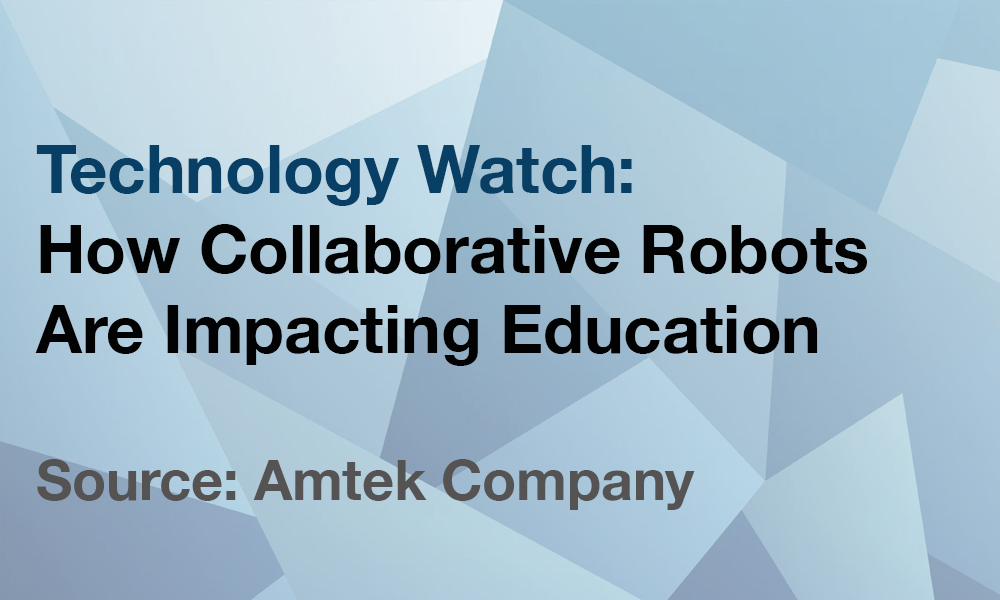Source: Amtek Company (Rick Sykes)
A few weeks ago I was sitting in the waiting room at the hospital receiving an update from one of the surgeons on staff. My wife’s surgery had gone well. It only lasted 45 minutes (as opposed to two hours) and she only lost a teaspoon of blood. I felt a wave of relief.
What had made her surgery so successful was the collaborative robot the surgeon used to perform the procedure. I’ve worked with collaborative robots for some time now, but to experience the benefits in my personal life has given me a new perspective.
Collaborative robots have grown in popularity across several industries over the past several years, especially manufacturing and healthcare. How? Let’s start at the beginning.
A collaborative robot is essentially a robot that works with a human to produce or accomplish something. There are a few different types of collaborative robots:
Hand Guiding Robots
This type of collaboration uses regular industrial robots with an added device – most commonly a Force Torque Sensor. The device reads the forces applied on the robot tool. This type of collaboration only applies to the robot while it is performing this particular function, which means that while the robot is functioning in its other modes, the robot still needs to have safeguarding in place.
Speed and Separation Monitoring Robots
Speed and Separation Monitoring robots are designed for occupational safety and are most commonly used in manufacturing environments. They work collaboratively with workers, but have safety precautions built in to keep workers safe.
- A Safety Monitored Stop is when the robot stops because someone or something gets too close. The robot must wait until the worker gives a signal before it can resume operations.
- A Separation Monitoring robot will continually work within its designated safety zones. Each zone is gradated so that the robot produces different reactions according to the location of the worker within each zone. The robot can also enlist a Safety Monitored Stop when a worker gets too close to it.

Imagine a manufacturing environment in which a worker is completing multiple tasks and may need a specific tool for only a few minutes within the day. A collaborative robot could deliver this tool safely, slowing down as it enters the worker’s space, arriving just at the time the worker needs it. The robot helps to speed up the manufacturing process and ensure a safe working environment.
Or imagine a manufacturing plant with a heavy sheet metal press, and there is a pinch point where a worker could easily cut their finger. This is where a collaborative robot could step in and handle the dangerous tasks while workers can handle the next steps in the process.
Power and Force Limiting Robots
This is the robot you think of when you hear the term “collaborative robot.” It can work side-by-side with a worker on a specific task without any additional safety devices. It is designed to detect abnormal forces in its path and will stop when it reads an overload.
In the instance of my wife’s surgery, the surgeon used the most widely known medical robot – the da Vinci Surgical System. This system essentially brings superhuman precision to surgical procedures. You can see for yourself in this video.
The cameras on the robot arms can zoom in on microscopic tissues better than a surgeon’s eyes. The result for my wife was a shorter surgery that minimized the effects of anesthesia, shortened her recovery time, and minimized her blood loss.
Collaborative Robots in Education
We’re seeing collaborative robots used in two distinct ways within education.
Universities are studying how to unleash the ultimate potential of collaborative robots across several different industries. They are uncovering new uses and applications, improving existing applications, enhancing robot efficiency, and studying robots’ effects on health and occupational safety in the workplace.
Several universities around the world are studying the use of KUKA’s lightweight, collaborative robot for various medical procedures. The KUKA LBR iiwa is designed to be inherently safe out of the box, without the need for elaborate safety fencing common to many industrial robots. This allows them to work in close proximity with their human operators.
Universities and community colleges also deploy robots, like Universal Robots, to teach students about the up and coming skills and technologies they’ll need to know to enter the workforce. Schools like Johns Hopkins, The University of Maryland, Virginia Tech, Marshall University, and others have collaborative robot education centers that expose students to the robots of the future and offer robotics research opportunities.
Collaborative robots are ushering in the new era of Industry 4.0 and students need to understand the workplace of the future and be prepared to meet the challenges of the coming decades.

